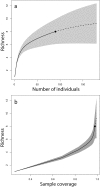Unveiling the Hidden Bat Diversity of a Neotropical Montane Forest
- PMID: 27706168
- PMCID: PMC5051729
- DOI: 10.1371/journal.pone.0162712
Unveiling the Hidden Bat Diversity of a Neotropical Montane Forest
Abstract
Mountain environments, characterized by high levels of endemism, are at risk of experiencing significant biodiversity loss due to current trends in global warming. While many acknowledge their importance and vulnerability, these ecosystems still remain poorly studied, particularly for taxa that are difficult to sample such as bats. Aiming to estimate the amount of cryptic diversity among bats of a Neotropical montane cloud forest in Talamanca Range-south-east Central America-, we performed a 15-night sampling campaign, which resulted in 90 captured bats belonging to 8 species. We sequenced their mitochondrial cytochrome c oxidase subunit I (COI) and screened their inter- and intraspecific genetic variation. Phylogenetic relations with conspecifics and closely related species from other geographic regions were established using Maximum Likelihood and Bayesian inference methods, as well as median-joining haplotype networks. Mitochondrial lineages highly divergent from hitherto characterized populations (> 9% COI dissimilarity) were found in Myotis oxyotus and Hylonycteris underwoodi. Sturnira burtonlimi and M. keaysi also showed distinct mitochondrial structure with sibling species and/or populations. These results suggest that mountains in the region hold a high degree of endemicity potential that has previously been ignored in bats. They also warn of the high extinction risk montane bats may be facing due to climatic change, particularly in isolated mountain systems like Talamanca Range.
Conflict of interest statement
The authors have declared that no competing interests exist.
Figures




Similar articles
-
Neotropical bats: estimating species diversity with DNA barcodes.PLoS One. 2011;6(7):e22648. doi: 10.1371/journal.pone.0022648. Epub 2011 Jul 26. PLoS One. 2011. PMID: 21818359 Free PMC article.
-
DNA barcoding of Jamaican bats: implications to Neotropical biodiversity.Mitochondrial DNA A DNA Mapp Seq Anal. 2016 Jul;27(4):3013-9. doi: 10.3109/19401736.2015.1063047. Epub 2015 Aug 14. Mitochondrial DNA A DNA Mapp Seq Anal. 2016. PMID: 27158792
-
Genetic and ecological processes promoting early diversification in the lowland Mesoamerican bat Sturnira parvidens (Chiroptera: Phyllostomidae).Mol Phylogenet Evol. 2017 Sep;114:334-345. doi: 10.1016/j.ympev.2017.06.015. Epub 2017 Jun 21. Mol Phylogenet Evol. 2017. PMID: 28647618
-
Diversification of the yellow-shouldered bats, genus Sturnira (Chiroptera, Phyllostomidae), in the New World tropics.Mol Phylogenet Evol. 2013 Sep;68(3):683-98. doi: 10.1016/j.ympev.2013.04.016. Epub 2013 Apr 28. Mol Phylogenet Evol. 2013. PMID: 23632030
-
Review of genetic diversification of bats in the Caribbean and biogeographic relationships to Neotropical species based on DNA barcodes.Genome. 2017 Jan;60(1):65-73. doi: 10.1139/gen-2015-0204. Epub 2016 Sep 14. Genome. 2017. PMID: 27936933
Cited by
-
Comparing the efficiency of monofilament and regular nets for capturing bats.R Soc Open Sci. 2021 Dec 8;8(12):211404. doi: 10.1098/rsos.211404. eCollection 2021 Dec. R Soc Open Sci. 2021. PMID: 34909218 Free PMC article.
-
The taxonomic status of Myotis nesopolus larensis (Chiroptera, Vespertilionidae) and new insights on the diversity of Caribbean Myotis.Zookeys. 2021 Feb 10;1015:145-167. doi: 10.3897/zookeys.1015.59248. eCollection 2021. Zookeys. 2021. PMID: 33623474 Free PMC article.
-
Environmentally driven phenotypic convergence and niche conservatism accompany speciation in hoary bats.Sci Rep. 2022 Dec 19;12(1):21877. doi: 10.1038/s41598-022-26453-y. Sci Rep. 2022. PMID: 36536003 Free PMC article.
References
-
- Brown JH. Mammals on mountainsides: elevational patterns of diversity. Glob Ecol Biogeogr. 2001; 10: 101–109. 10.1046/j.1466-822x.2001.00228.x - DOI
-
- Černý T, Kopecký M, Petřík P, Song J-S, Šrůtek M, Valachovič M, et al. Classification of Korean forests: patterns along geographic and environmental gradients. Appl Veg Sci. 2015; 18: 5–22. 10.1111/avsc.12124 - DOI
-
- Magige FJ. Rodent species diversity in relation to altitudinal gradient in Northern Serengeti, Tanzania. Afr J Ecol. 2013; 51: 618–624. 10.1111/aje.12075 - DOI
MeSH terms
Substances
LinkOut - more resources
Full Text Sources
Other Literature Sources

